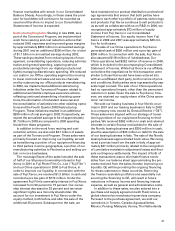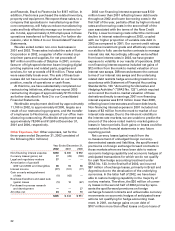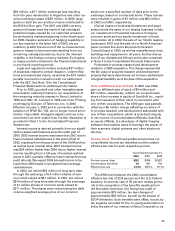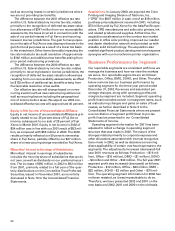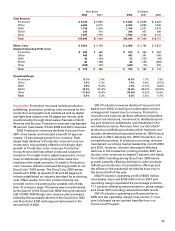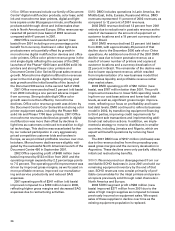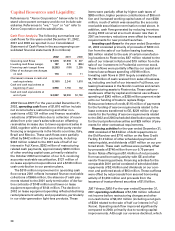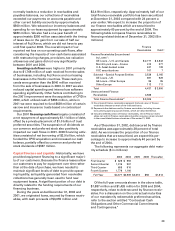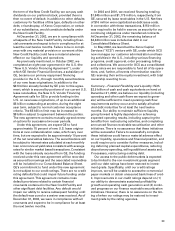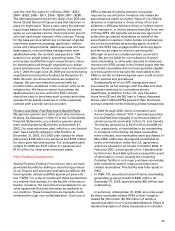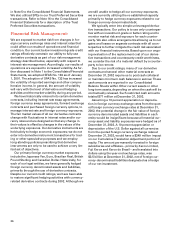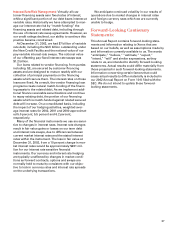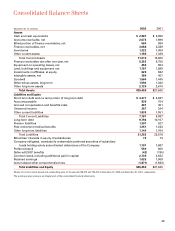Xerox 2002 Annual Report Download - page 33
Download and view the complete annual report
Please find page 33 of the 2002 Xerox annual report below. You can navigate through the pages in the report by either clicking on the pages listed below, or by using the keyword search tool below to find specific information within the annual report.
31
• In June 2001, we announced several Framework
Agreements with GE under which they became our
primary equipment-financing provider in the U.S.,
Canada, Germany and France. In October 2002 we
finalized an eight-year U.S. arrangement and fund-
ing commenced in the fourth quarter of 2002. We
are currently negotiating other GE arrangements
under the respective Framework Agreements.
• In April 2001, we sold our leasing businesses in
four Nordic countries to a company now owned by
GE and retained interests in certain finance receiv-
ables. These sales are part of an agreement under
which that company will provide ongoing, exclu-
sive equipment financing to our customers in those
countries.
• In December 2001, we formed a joint venture with
De Lage Landen International BV (“DLL”) which
manages equipment financing, billing and collec-
tions for our customers’ equipment orders in the
Netherlands. This joint venture began funding in
the first quarter of 2002. DLL owns 51 percent of
the venture and provides the funding to support
new customer leases. We own the remaining 49
percent of this unconsolidated venture.
• In March 2002, we signed agreements with third
parties in Brazil and Mexico under which those
third parties became our primary equipment
financing providers in those countries. Funding
under both of these arrangements commenced in
the second quarter of 2002.
• In April 2002, we sold our leasing business in Italy
to a company recently acquired by GE, as part of an
agreement under which GE will provide on-going,
exclusive equipment financing to our customers in
Italy.
• In December 2002, we securitized existing state and
local government finance receivables in the U.S.
with GE.
• In December 2002, we securitized existing finance
receivables in France with a 364-day financing with
Merrill Lynch (“ML”). ML intends to replace this
financing with a long-term public secured offering
during 2003.
• In December 2002, we received a series of financ-
ings from our unconsolidated joint venture with
DLL, secured by our lease receivables in Holland.
• In December 2002, we received loans from GE
secured by finance receivables in Germany.
New Credit Facility: In June 2002, we entered into an
Amended and Restated Credit Agreement (the “New
Credit Facility”) with a group of lenders, replacing
our prior $7 billion facility (the “Old Revolver”). At that
time, we permanently repaid $2.8 billion of the Old
Revolver and subsequently paid $710 million on the
New Credit Facility. At December 31, 2002, the New
Credit Facility consisted of two tranches of term loans
totaling $2.0 billion and a $1.5 billion revolving credit
facility that includes a $200 million letter of credit sub-
facility. At December 31, 2002, $3.5 billion was out-
standing under the New Credit Facility. At December
31, 2002 we had no additional borrowing capacity
under the New Credit Facility since the entire revolving
facility was outstanding, including a $10 million letter
of credit under the subfacility. Xerox Corporation is the
only borrower of the term loans. The revolving loans
are available, without sub-limit, to Xerox Corporation
and to Xerox Canada Capital Limited (“XCCL”), Xerox
Capital Europe plc (“XCE”), and other foreign sub-
sidiaries as defined. Xerox Corporation is the borrower
of all but $50 million of the revolver at December 31,
2002. The size and contractual maturities of the loans
are as follows ($ in millions):
2003 2004 2005 Total
Tranche A Term Loan $400 $600 $ 500 $1,500
Tranche B Term Loan 5 5 490 500
Revolving Facility – – 1,490 1,490
Total $405 $605 $2,480 $3,490
We are required to repay portions of the loans earli-
er than their scheduled maturities with specified per-
centages of any proceeds we receive from capital
market debt issuances, equity issuances or asset sales
during the term of the New Credit Facility, except that
the revolving facility cannot be reduced below $1 bil-
lion, as a result of such prepayments. Additionally, all
loans under the New Credit Facility become due and
payable upon the occurrence of a change in control.
Subject to certain limits described in the following
paragraph, all obligations under the New Credit
Facility are secured by liens on substantially all of the
domestic assets of Xerox Corporation and by liens on
the assets of substantially all of our U.S. subsidiaries
(excluding Xerox Credit Corporation (“XCC”)), and
are guaranteed by substantially all of our U.S. sub-
sidiaries. In addition, a revolving loan outstanding to
XCCL ($50 million at December 31, 2002) is secured
by all of its assets, and is guaranteed by certain
defined material foreign subsidiaries.
Under the terms of certain of our outstanding pub-
lic bond indentures, the amount of obligations under
the New Credit Facility that can be (1) secured by
assets (the “Restricted Assets”) of (a) Xerox
Corporation and (b) our non-financing subsidiaries
that have a consolidated net worth of at least
$100 million, without (2) triggering a requirement to
also secure those indentures, is limited to the excess
of (1) 20 percent of our consolidated net worth (as
defined in the public bond indentures) over (2) the
outstanding amount of certain other debt that is
secured by the Restricted Assets. Accordingly, the
amount of New Credit Facility debt secured by the


